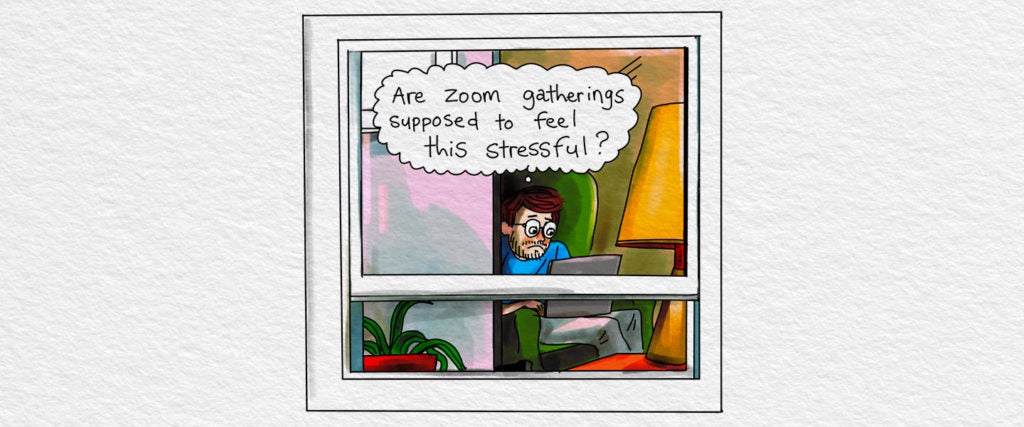The memoir, as a genre of nonfiction, presents a dubious narrative challenge: How can anyone tell their life story while they’re still living it? That is, what’s the best way to tell a story of a life in progress? Of a recovery in progress?
For New Yorker cartoonist Jason Adam Katzenstein, there’s one obvious answer — images. With them, he rises to that daunting literary challenge in his new graphic memoir, Everything Is An Emergency: An OCD Story in Words and Pictures, a sensitive, sweet and self-aware account of his life with obsessive-compulsive disorder.
Obsessive-compulsive disorder, or OCD, is a relatively well-known psychiatric ailment, enough so that its name has become a colloquialism for neurosis or merely strong preference (e.g., “I’m kind of OCD about keeping my room clean”). As with any terminology-turned-catchphrase, the popular understanding of obsessive-compulsive disorder misinterprets what OCD actually is — an overwhelming fixation on imagined fears or impulses (the “obsessive” component), followed by predetermined and sometimes repeated actions to relieve the excruciating tension of the obsessive object (the “compulsion”). Habits of OCD can include things like continual handwashing or constant checking — Is the stove off? Is it really off? — as well as tightly-guarded ordering of spaces, sometimes with the aim of symmetry.
When untreated or in a high state of distress, OCD behaviors can begin as prevention (like, again, handwashing), but due to the sheer amount of repetition, lead to self-harm (like bleeding and chapped skin from extreme overwashing of hands). A lot of OCD takes place in imagined space, as those who have it only outwardly demonstrate via compulsions half of what their condition includes.
Everything Is An Emergency then gives us a thoughtful window into what having OCD can look — and feel — like. Those familiar with Katzenstein’s style from The New Yorker will recognize it here: Black-and-white line drawings shaded with washes of grey, juxtaposing real-world elements with humor ranging from the silly (on a page reading, “I’ve hit rock bottom,” a cheekily grinning rock moons our tearful protagonist) to references to cinematic and literary tropes (comic-book-style full-page bleeds of the four main “characters” of his OCD: contamination, guilt, panic and relationships). Everything Is An Emergency is generally a traditional graphic memoir, though Katzenstein’s drawings are occasionally complemented by real artifacts (childhood diary entries; early comic drafts submitted to The New Yorker), and during scenes of panic attacks, the lines become heavy and dark and the lines of speech bubble text become smudged and foggy.
From early on, young Jason — big eyed and tiny — learns that he struggles with containing overwhelming thought spirals, and that in creating art, he’s able to make them more manageable. Poignantly, teenage Jason admires the Surrealist paintings of Salvador Dalí. He praises their bravery; how stomach-churning nightmares — the very same dark fantasies that normally wreak havoc on an OCD mind — are shrunken to controllable size in Dalí’s paintings.
Like Dalí’s transformation of psychological anguish into art, the narrative form of Everything Is An Emergency imitates the repetitive thought patterns of someone with OCD, ultimately leading to a thought-provoking representation of the “road to recovery.” Throughout the book, the cycle of obsession and compulsion is explained through consistent visual motifs — e.g., the top of Jason’s head is replaced with a scratched, repeating record (“Your hands are dirty. [scrtchh] Your hands are dirty. [scrtchh] Your hands are dirty,” it reminds him), and a recurring childhood nightmare.
In another nightmare, a woman in an empty room sits with a cat on her lap. Jason, represented as a child, compliments the cat. She thanks him. He compliments the cat. She thanks him. He leaves the room, but knows he has to come back. In a long-distance face-off like an old Western, he and the woman stare each other down. There are close-up details of his scowl, her pursed lips. He knows he’s expected to say his line, but he refrains. The tension builds. He stares. She stares. Her eyes begin to glow and grow, and suddenly, her face melts. The woman transforms, massive and terrifying, into a sharp-toothed monster, leering over our young protagonist, who quakes in fear until, knowing what is expected, he musters his compliment again, petrified.
She shrinks back to her normal size, and smiles politely. The pattern continues. Jason gets older. In moments of distress, a frame of the woman holding the cat reappears, evoking an internal sensation of lifelong encoded distress signals that often prompt a return to compulsive behaviors.
When I speak with Katzenstein via Zoom, he explains what he saw as the somewhat seamless connection between his experience of OCD and his process of creating Everything Is An Emergency. In therapy, “one thing I realized is how literary OCD is,” he tells me. “The way I’ve learned to talk about it is in terms of themes: There’s the contamination theme. The guilt and responsibility theme. And the rule in drama is to make clear what the stakes are for your character, and then to put that thing in jeopardy.” Because OCD comes paired with its own set of values, as well as a sense of high stakes and a sensation of being constantly in jeopardy, the disorder lent itself naturally, Katzenstein found, to exploration through narrative.
Such a perspective offers an interesting insight to the most moving of Everything Is An Emergency’s tropes, one that pushed the narrative structure to a place of meta-commentary. Throughout the book, Katzenstein intentionally intersperses a cartoon of himself as an adult pushing a massive boulder up a hill. Though the cartoon is never explained, it references Sisyphus, a king of Greek mythology who is cursed by Zeus to spend eternity pushing a boulder up a hill. Once it gets to the top, the boulder will fall to the bottom again, the cycle repeating.
This drawing is a frequent symbol in the book — perhaps the most repeated visual metaphor, starting on Everything Is An Emergency’s very first page. Jason-as-Sisyphus appears almost like chapter breaks, demonstrating a move toward a climactic challenge or a breakthrough. Predictably, there are moments when Jason successfully pushes the boulder to the top of the hill, and fist pumps jubilantly. The next time the image re-emerges, however, the boulder flies to the bottom once more — but of course — Jason running desperately behind it.
As the book continues, and Jason progresses from child to teen to cognizant adult, dancing with his disorder, our image of Jason-as-Sisyphus doesn’t find resolution. Rather, the very nature of this visual metaphor is the knowledge that his quest to push his boulder to the top of his mountain, to triumph over his OCD, will never be complete.
Which isn’t to say Katzenstein’s story is a tragic one. Rather, in an honest way, he uses his Sisyphean relationship to OCD as a means of speaking to what it is to live with mental illness, a constant back-and-forth of ups and downs, challenge and strength. Because the rock has been pushed up the hill doesn’t mean it won’t fall down again. But by the same measure, because the rock has sped to the bottom doesn’t mean it can’t be brought back up.
That, too, is perhaps the book’s most universal theme. As even for those without OCD, Katzenstein recommends working toward building peace with uncertainty (which is particularly relevant in these highly uncertain times), and articulating what specific things you can do to make yourself feel better. Or like he tells me, “There’s a lot of stuff we can all do to tend to our mental health on a day-to-day basis. And maybe doing that stuff and whatever that means for you instead of trying to rationalize your way through to answers to big questions that nobody can answer is a more meaningful way to use your time right now.”

